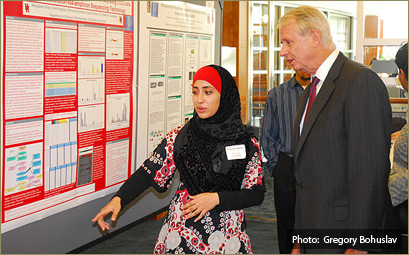By Rolando Garcia
Natural Sciences and Mathematics Communications

Trace the family tree back far enough – way past the chimpanzee and Neanderthal – and you might find a microscopic parasite, according to a University of Houston student researcher.
Mahjabeen Khan, a senior biology major, found a possible evolutionary link between mammals and an ancient type of protozoa called trypanosome. She presented her findings at UH’s Undergraduate Research Day last month, and Khan’s project was selected as one of the three best from among dozens of the university’s top budding researchers.
Khan’s research began in the genetics lab of Preethi Gunaratne, assistant professor of biology and biochemistry. Gunaratne’s group is working to understand the role of microRNA in stem cells during early development and in relation to disease. In the last decade, these tiny RNAs have catapulted into the limelight as important agents of gene silencing.
While poring over data from the latest genetic sequencing technology, Khan and other students in the lab found that the microRNAs undergo extensive nonclassical modification through a process called RNA editing in the pancreatic and insulin-secreting beta cells in mice. This suggests that remnants of an ancient RNA editing mechanism found in trypanosomes may be present in mammals.
Trypanosomes are single-celled parasites often found in insects. They can cause diseases such as sleeping sickness when their blood-sucking hosts – like tsetse flies – bite humans.
The match suggests an evolutionary link between the trypanosome and mice that might also extend to humans, since the two mammals share similar genomes, Khan said.
This genetic similarity is partly why mice are often the subject of lab research.
Khan, who will graduate in December, hopes to publish her findings. She submitted her project for the Undergraduate Research Day poster contest. The event featured research from students who participated in the Summer Undergraduate Research Fellowship (SURF), a 10-week fellowship in which students conduct original research under the guidance of a faculty member.
The contest was also open to students like Khan who had done substantive research but were not part of the SURF program. Khan competed against more than 50 other students from business, science, engineering, liberal arts and other colleges.
Khan’s research experience began after taking Gunaratne’s genetics class. Each year Gunaratne picks a handful of her best students to work in her lab to give them a taste of research in genomics and microRNA and to cultivate budding scientists.
The research is a joint effort between UH and collaborators at Baylor Human Genome Sequencing Center and Texas Children’s Hospital, where Gunaratne holds dual appointments. The informal program has trained more than 60 UH undergraduates within two years.
“Those with potential show initiative and rise to the top and Mahjabeen really stepped up,” Gunaratne said. “She’s been quite remarkable.”
Although research is a time-consuming enterprise requiring countless hours of toiling in a lab, the experience has been even more rewarding than she had hoped, Khan said.
“Working as part of a team is what I like the most,” she said.
With graduation looming, Khan now is weighing whether to pursue medical school or a graduate biology degree to continue her research. |

